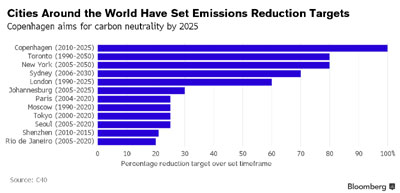At COP21, cities were in the limelight with the largest gathering of mayors in history – representing 640 cities from 115 countries at the Climate Summit for Local Leaders.
The event culminated in the Paris City Hall Declaration, where they pledged support for emissions cuts of 80% by 2050 while achieving 100% renewable energy.
Most importantly, cities can fill the yawning gap left by country climate pledges. Surprisingly, even though cities are home to half the world’s population – growing to two-thirds by 2050, according to the UN – they tend to be omitted from country pledges, which focus on economy-wide reductions from electricity and industry, for example.
Cities produce 80% of economic output and generate 70% of greenhouse gas emissions, according to C40 Cities.
The Declaration commits cities to deliver about 30% of the difference: we "will deliver up to 3.7 gigatons of urban greenhouse gas emissions reductions a year by 2030 and 8.0 GtCO2e in 2050."

Cities and local governments can deliver big emission cuts through their authority for urban planning, waste reduction and recycling, and transportation. They can require deep energy retrofits of existing buildings and strong efficiency standards for new buildings; aggressive energy performance standards for urban lighting and appliances; and by offering efficient transit to residents, according to "Advancing Climate Ambition: Cities As Partners in Global Climate Action."
The City Energy Project – which drives down energy use in commercial buildings – had a successful first two years, and is investing another $10 million starting in 2016. So far, 10 cities have cut emissions equal to a million cars a year, saving nearly $1 billion a year.
The Compact of States and Regions also made a huge commitment – to reduce emissions by 12.4 GtC02e by 2030 – more than China’s current annual output.
Other Major Announcements at COP21:
- Green Building Councils across the world pledged to certify another 1.23 billion square meters of green buildings in the next five years. And a new alliance of 16 countries formed – the Global Alliance for Buildings and Construction.
- Global Lighting Challenge: backed by 13 countries, the goal is to install 10 billion of the most efficient light bulbs as quickly as possible – which would displace 684 coal-fired power plants for a year. Lighting alone causes 5% of global emissions.
China will work to achieve domestic sales of over 5 billion LEDs in the next two years and India, 770 million LED bulbs and 35 million street lights in the next three years. Ikea’s goal is to sell over 500 million LED bulbs by the end of 2020.
- Global Geothermal Alliance launched with 38 countries and a goal to increase capacity 500% for electricity generation and 200% for heating by 2030. Only 13 gigawatts is currently installed worldwide.
- Green Freight Action Plan, endorsed by 20 countries and Volvo, Ikea, Hewlett Packard and Deutsch Post DHL, will address black carbon and fine particle pollutants in the industry. The goal is to bring in 20 more countries by 2018, and for the top 100 global shippers to actively mitigate these climate forcers by 2025.
- The EU’s Circular Economy Package requires that 65% of municipal waste and 75% of packaging be recycled, cutting waste to landfills to a maximum 10% of disposal. This will reduce EU emissions by another 2-4% by 2030. Unfortunately, it leaves out compostable waste, which accounts for 30-45% of municipal waste – about a quarter of which is currently recycled. They plan to approve a target to cut marine waste of 50% by 2025.
Read our article, World’s Cities Making Progress on Green Building.
